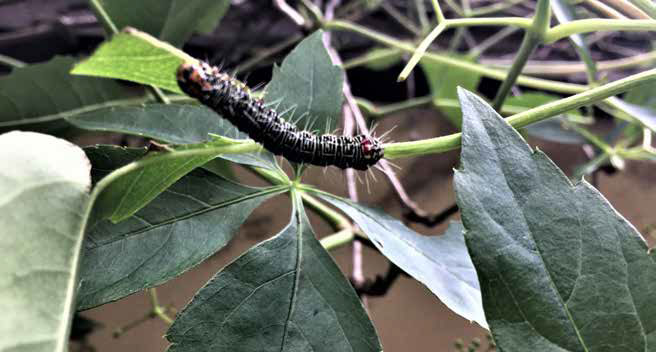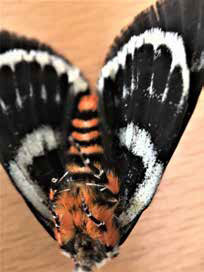Article and Photos: Ange McNeilly (Canberra Organic – Autumn 2021)


Opening the front door on Wednesday, 17 December 2020, I noticed that the veranda floor was covered in black spots and the Virginia Creeper growing along the eaves and gutter was being stripped bare by an infestation of caterpillars! These are the caterpillars of the Australian Grapevine Moth (Phalaenoides glycinae). The caterpillars were also on the grapevines.
It was cringe-making to see so many caterpillars! As I do not use chemical sprays, I wore gloves and picked off each caterpillar and placed it into a bucket, which was filled with hot soapy water. Information provided by the NSW Government Department of Primary Industries about this particular pest states:
Grapevine moth is native to Australia and feeds on several native plants as well as grapevine leaves. The adult is an attractive black moth with white and yellow markings, a wingspan of about 6 cm, and tufts of orange hair on the tip of the abdomen and around the legs. Moths are dayflying, gregarious and feed on nectar and pollen. Moths emerge from overwintering pupae in early spring and lay eggs on stems and leaves. Eggs are round, sculptured and green to brown in colour depending on the stage of development. The larval or caterpillar stage goes through six larval instars or moults. The caterpillar is mainly black and white with red markings, covered in scattered white hairs, and can reach 5 cm in length. Pupation occurs in a silken cell in the ground or in fissures in the vine wood or strainer posts. The pupa is the overwintering stage. There are two to three annual generations with larvae first appearing on vines in October, and the second generation of moths appears in December. In areas with warm to hot summers, a third generation may occur between late summer and autumn.
NSW Government Department of Primary Industries
Grapevine moth is usually a minor pest, with little economic impact. However, if caterpillar numbers reach high levels, severe vine defoliation may result, which can affect berry development and carbohydrate storage. Caterpillars feed on leaves but may begin feeding in bunches if foliage is depleted. Parasitoids such as tachinid flies and wasps, predatory shield bugs and birds provide some control against the pest. Several insecticides are registered for grapevine moth.
To accompany this, an interesting fact was taken from Wikipedia: “the Indian myna (Acridotheres tristis) was introduced into Australia in 1862 to deal with a number of insect pests including the grapevine moth. In this it was unsuccessful, and ironically the bird is now itself considered a pest in many parts of Australia.”